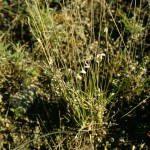Hall Panicum , Hall's Panicgrass
Panicum hallii Vasey
Poaceae
Description
Stems grow in small, erect tufts. The stems are typically solitary or scarcely branched at the base. Blades are flat, slick, and often clustered at the base of the plant. Basal blades curl when dry, resembling wood shavings. The ligule is a ciliate membrane or fringe of hairs. Seedheads reach up to 8 inches or 20 cm long, and panicles ascend above the leaves. The single-seeded spikelets are borne on very short pedicels and are closely spaced in small, overlapping clusters. The first glume is shorter than the second glume. The mature lemma are shiny. Flowering occurs from June to October. The seeds turn dark brown and shiny when ripe. Hall panicum is a perennial, warm-season, native species ranging from 12 to 24 inches or 30 to 60 cm tall. Fair grazing for livestock and wildlife. Its palatability declines as it ages.Habitat
Grows on dry prairies, rocky and gravelly hills, and bottomlands. Increases in overgrazed ranges. It can be found in several states including Arizona, Colorado, Louisiana, New Mexico, Oklahoma, Texas, and Utah.Images
Plant Characteristics
Seed Type: Non-Encapsulated
Duration: Perennial
Stem Texture: Hairy
Growth Habit: Bunch grass, Grasses
Leaf Shape
 : Simple with Pinnate or Parallel Venation
: Simple with Pinnate or Parallel Venation
Season: Warm
Distribution
 : 02 - Gulf Prairies and Marshes, 03 - Post Oak Savannah, 04 - Blackland Prairies, 05 - Cross Timbers and Prairies, 06 - South Texas Plains, 07 - Edwards Plateau, 08 - Rolling Plains, 09 - High Plains, 10 - Trans-Pecos
: 02 - Gulf Prairies and Marshes, 03 - Post Oak Savannah, 04 - Blackland Prairies, 05 - Cross Timbers and Prairies, 06 - South Texas Plains, 07 - Edwards Plateau, 08 - Rolling Plains, 09 - High Plains, 10 - Trans-Pecos
Distributions
Distribution refers to the ecological region in Texas that a plant has been found. You can also view a clickable map.
Book: Know Your Grasses (B-182)
Collection: Grasses



